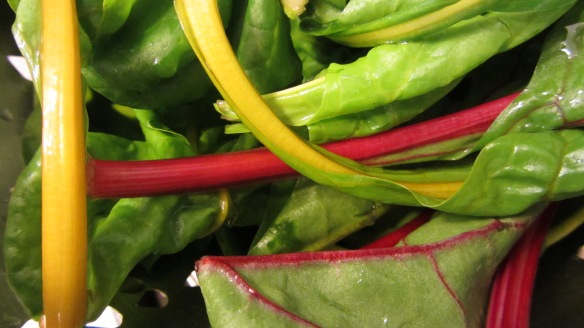In which there is actually a recipe.
…
Warm greens* salad
*you can use kale, (swiss) chard, collard greens, beet greens, and/or spinach
Ingredients:
+ quinoa or rice or pearl barley or whole grain pasta or a baked or roasted potato or skip this ingredient altogether
+ cooking oil
+ garlic (a clove or two, pressed/crushed/minced)
+ onion (chopped/sliced/whatever– preferably red, but shallots or any cooking onion will do)
+ veggies: any appealing-to-you greens, or combination thereof [kale, beet greens, chard, collard greens, spinach], carrots, parsnips, beets, mushrooms, cauliflower, broccoli. I shred the greens by hand, shave the carrots and/or parsnips with a peeler for quick cooking, and I usually boil/roast the beets all at once when I first get them so I can add them at the end just to heat them up.
+ optionally: (if you feel fancy) goats cheese (without cheese, this is a vegan dish, by most definitions) &/or frozen or fresh raspberries or blueberries (a handful or two, squished), balsamic vinegar, and olive/sunflower/grapeseed oil for a vinaigrette (1 part vinaigrette to 3 parts oil)
Make:
1. rinse and scrub the quinoa in a fine sieve, put it in a pot with water (2 parts water to 1 part quinoa; add a stock cube if you desire) on high heat, bring it to a boil, reduce the heat and let simmer for about 15 minutes/until there’s no excess water. I find 1/4 to 1/3 cup of quinoa is a good single portion. (the veggies also works well with a baked potato, or on their own)
2. while you’re letting the quinoa go, heat up cooking oil in a pan on medium heat, and throw in the garlic, cook for 30 seconds to a min.
3. add the onion and cook for a few minutes
4. add other veggies before the onion gets translucent: carrots, parsnips, pre-cooked beets, whatever (I sometimes add a little water and cover the pan to cook the veggies faster)
5. cook your greens! you can (1) add your greens to the pan with a little water and cover up the pan to steam them for a minute or two, or (2) add your greens to the quinoa while there is still a bit of water in the pot, or (3) stem the greens in a colander over the pot with the cooking quinoa, or (4) pour a little boiling water over the greens in a strainer/colander to cook them instantly
6. mix all the veggies together with the quinoa and serve warm (with goats cheese and/or berry vinaigrette on top)
alternatively, you can roast any good roasting veggies (several whole garlic cloves, onion, carrot, parsnip, beets, cauliflower) tossed with oil, salt and pepper in a baking dish in the oven at 250˚ or so, adding mushrooms and greens towards the end, and mixing the quinoa in at the end. However, this might take a little longer (45 min to an hour)


